As mindfulness gains popularity and governments begin to study the impact mindfulness has on students, some people may be wondering: is teaching meditation to students a good thing?
In this video from Vox, Liz Scheltens explores how mindfulness is making its way into US schools.
Why Bring Meditation to Schools?
Harvard researcher Sara Lazarstudies how yoga and meditation impact cognitive function. After noticing how her own yoga practice calmed her, she was interested in learning whether it was a placebo response of if meditation could change the brain. She decided to study the brains of people who had never meditated—first with a brain scan before they participated in an 8-week, 30-minute meditation program.
Lazar noticed changes in different brain regions—in particular, thickness increased in certain areas of the brain related to learning, memory, and emotion regulation (the hippocampus) as well as perspective-taking, empathy, and compassion (the temporoparietal junction).
[Kids] are more likely to take the skills home and teach the parents, to teach people in their community, and that’s how we’ve seen the biggest change we made.
While it’s not yet clear that students’ brains will undergo the same kinds of changes, the Holistic Life Foundation has seen first-hand the benefits of bringing mindfulness to the classroom.
“We’re not just teaching kids to use the skills and tools, but we also teach them to be teachers,” said executive director Ali Smith. “Because they’re more likely to take the skills home and teach the parents, to teach people in their community, and that’s how we’ve seen the biggest change we made.”
Even small changes, like teaching a class outside or building kindness into the curriculum can go a long way.
The Criticism of Meditation in Schools
Some worry that bringing meditation to schools acts as a gateway to Buddhism, in what is supposed to be a secular environment.
Others, such as David Forbes, a professor in the School Counseling program at CUNY, argue meditation programs target schools with students of color. Forbes said the practice encourages kids to be passive and “adjust to situations that many of us think people should adjust to.”
However, Bruce Gill, who runs the meditation program at Eastern High School in Washington, DC, and is Executive Director of Minds Incorporated, suggests mindfulness can give students important tools to navigate a fraught system.
“We don’t want them to react in the face of a threat from a police officer in such a way that provokes something destructive happening, that provokes something fatal happening,” Gill tells Scheltens.
Three Ways to Bring Mindfulness to Classrooms
- Explore the case studies: There’s a school in Dallas, Texas that has been incorporating mindfulness into their curriculum for almost 20 years and tracking their kids’ progress. They’ve accumulated significant data showing the positive effects of incorporating mindfulness into education. Their students are learning essential skills for handling stress, plus improving their memory, capacity to plan and organize, and to feel empathy, all the while improving their test scores.
- Build better programs: “You wouldn’t ask a teacher who can’t swim to teach a swimming class from a textbook,” says Jamie Bristow, director of The Mindfulness Initiative. He suggests four ways to avoid poorly designed school mindfulness programs and how to get your community to help a mindfulness program thrive.
- Don’t forget the teachers: According to recent research, training teachers in mindfulness can improve well-being in the classroom.








